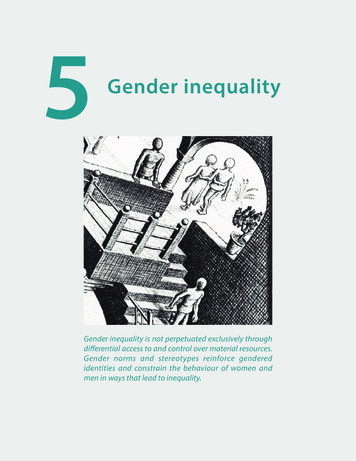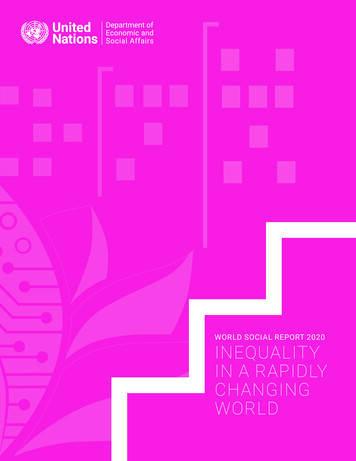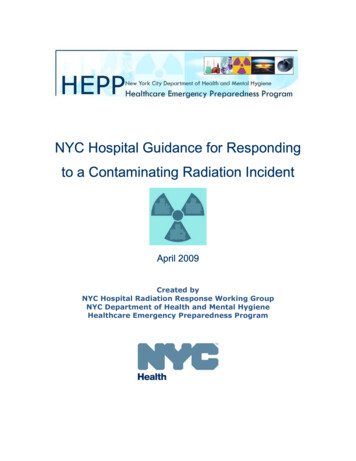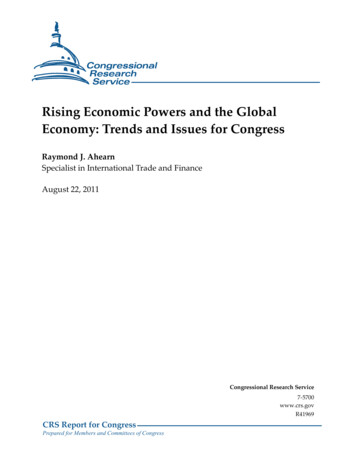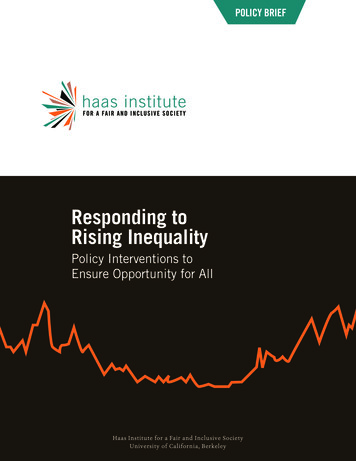
Transcription
POLICY BRIEFResponding toRising InequalityPolicy Interventions toEnsure Opportunity for AllHaas Institute for a Fair and Inclusive SocietyUniversity of California, Berkeley
This policy brief is published by the Haas Institute for a Fair and Inclusive Societyat the University of California, Berkeley.The Haas Institute for a Fair and Inclusive Society at UC Berkeley brings together researchers,community stakeholders, policymakers and communicators to identify and challenge the barriersto an inclusive, just, and sustainable society and create transformative change.The Institute serves as a national hub of a vibrant network of researchers and community partnersand takes a leadership role in translating, communicating and facilitating research, policy andstrategic engagement. The Haas Institute advances research and policy related to marginalizedpeople while essentially touching all who benefit from a truly diverse, fair and inclusive society.DIRECTORSAUTHORSjohn a. powellJustin Steil is a doctoral candidate in urbanplanning at Columbia University. He is a co-editorof Searching for the Just City: Debates in UrbanTheory and Practice (Routledge 2009).Director, Haas Institute for a Fair and Inclusive SocietyRobert D. Haas Chancellor’s Chair in Equity and InclusionProfessor of Law, African American, and Ethnic StudiesUniversity of California, BerkeleyMichael OmiAssociate DirectorHaas Institute for a Fair and Inclusive SocietyAssociate Professor of Comparative Ethnic StudiesUniversity of California, BerkeleyStephen MenendianAssistant Director and Research Director,Haas Institute for a Fair and Inclusive SocietyCONTACT460 Stephens HallBerkeley, CA 94720-2330Tel: MEDIA INQURIESRachelle 29-0032SUPPORTThe Haas Institute thanks the Ford Foundation, theEvelyn and Walter Haas, Jr. Fund and the W.K. KelloggFoundation for support in making this report possible.Stephen Menendian is the Assistant Directorand Research Director of the Haas Institute fora Fair and Inclusive Society.Samir Gambhir of the Haas Institute provided thedata analysis and figures.RESEARCHThe research in this policy brief reflects the work ofthe UC Berkeley Haas Institute Economics DisparitiesResearch Cluster members listed below:Hilary HoynesDistinguished Cluster ChairProfessor of Public Policy and EconomicsDavid CardEconomicsRucker JohnsonGoldman School of Public PolicyPatrick KlineEconomicsPaul PiersonPolitical ScienceMichael ReichDirector, Institute forResearch on Labor and EmploymentRobert ReichGoldman School of Public PolicyEmmanuel SaezEconomics
TABLE OF CONTENTSAbout the Haas Institute. 5Introduction. 7Accelerating Inequality. 8A Growing Economy but a Shrinking Middle Class. 10Stalled Economic Mobility. 12Is Inequality Inevitable?. 13Minimum Wages. 13The Earned Income Tax Credit. 14Building Assets. 16Investments in Education. 17Tax Reform. 18Residential Segregation. 19Conclusion. 20Recommendations. 21Endnotes. 22
The rise in inequalityand its effects oneconomic mobilityare defining issues forAmerica’s future.
5ABOUT THE HAAS INSTITUTEFOR A FAIR AND INCLUSIVE SOCIETYThe Haas Institute for a Fair and Inclusive Society at UC Berkeley brings together researchers,community stakeholders, policymakers, and communicators to identify and challenge the barriers to an inclusive, just, and sustainable society and create transformative change. The Instituteserves as a national hub of a vibrant network of researchers and community partners and willtake a leadership role in translating, communicating and facilitating research, policy and strategic engagement. The Haas Institute advances research and policy related to marginalized peoplewhile essentially touching all who benefit from a truly diverse, fair and inclusive society.As part of the UC Berkeley Initiative for Equity, Inclusion, and Diversity funded by the Evelynand Walter Haas, Jr. Fund in 2010, the Haas Institute draws upon Berkeley’s considerable multidisciplinary research excellence and history of engaged scholarship. Organized into sevenresearch clusters, the Institute involves almost 100 researchers across the University of Californiasystem. At its core are eight endowed chairs focused on equity and inclusion — a force that isunprecedented at Berkeley and unparalleled in the nation.FACULTY RESEARCH CLUSTERSAt the heart of the Haas Institute are seven clusters of teaching and research that focus onaddressing society’s most pressing and pivotal issues related to vulnerable and marginalizedpopulations. The Haas Institute creates coherence among faculty clusters and provides strategicleadership, while endowed cluster chairs lead faculty members in aligning areas of research. Together, the Haas Institute and the research clusters advance research and policy that addresses thegame-changing issues that emerge.Our seven research clusters work in the following areas: Disability Studies; Diversity andDemocracy; Diversity and Health Disparities; Economic Disparities; LGBTQ Citizenship; Race,Diversity and Educational Policy; and Religious Diversity.The findings in this report synthesize recent research from faculty working in the EconomicDisparities Research Cluster. Cluster members are drawn from different disciplines acrossthe UC Berkeley campus.The endowed Economic Disparities Distinguished Cluster Chair is Hilary Hoynes, Professor of Economics and Public Policy. Economic Disparities cluster members include: HenryBrady, Dean, Graduate School of Public Policy; David Card, Economics; Karen Chapple,City and Regional Planning; Paul Groth, Geography; Percy Hintzen, African-AmericanStudies; Michael Johns, Geography; Rucker Johnson, Goldman School of Public Policy;Jane Mauldon, Goldman School of Public Policy; Patrick Kline, Economics; Enrico Moretti,Economics; Paul Pierson, Political Science; Steve Raphael, Goldman School of Public Policy;Michael Reich, Institute for Research on Labor and Employment; Robert Reich, GoldmanSchool of Public Policy; Jesse Rothstein, Goldman School of Public Policy; Emmanuel Saez,Economics; Stephen Small, African-American Studies; Ula Taylor, African-American Studies;and Richard Walker, Geography.HAAS INSTITUTE POLICY BRIEFResponding to Rising Inequality
6KEY FINDINGS Extremeconcentrations ofincome and wealthpose fundamentalchallenges toAmerica’s idealsof democracy andequal opportunity. Both inequality andeconomic mobilityvary substantially bymetropolitan regionwithin the U.S. Variation in inequalityand mobility implythat local, state, andfederal policies canhave an impact.A PLAN TO RESPONDPolicy interventions can address poverty and inequality: Raise theminimum wageto lift nearly onemillion peopleout of poverty. Invest in earlychildhoodeducation, whichis proven tohave significantbeneficial effectson long-termeducationalattainment andearnings.Responding to Rising Inequality Enhance the EarnedIncome Tax Credit toraise the incomes ofworking poor families. Adjust capital gainstax rates so that theyare commensuratewith income tax rates. Supporteconomic andracial integrationin neighborhoodsand schools. Shift savingsincentives from taxdeductions thatdisproportionatelybenefit the wealthyinto refundable taxcredits that providemore equal benefitsacross incomecategories. Ensure thatmortgages remainbroadly accessible,especially forcommunities ofcolor that haveexperiencedhistoricaldiscrimination inlending.HAAS INSTITUTE POLICY BRIEF
7INTRODUCTIONONE OF AMERICA’S DEFINING IDEALS isthe idea that opportunity is available toall, regardless of where one starts on theeconomic ladder.The reality is that income inequality hasgrown dramatically since the 1970s andthat increasing inequality has not beenmatched with growing economic mobility.Instead, the rungs on the ladder of economicadvancement are being pulled further apart:in 1970, the upper-class household at theninety-fifth percentile of income ( 122,294in 2012 constant dollars) had an incomeroughly three times that of the middle-classhousehold at the fortieth percentile of income ( 37,282 in 2012 constant dollars), but,by 2012, the household at the ninety-fifthpercentile ( 191,156) received nearly fivetimes the income of the fortieth percentilehousehold ( 39,674).1Increasing income inequality has contributedto rising levels of residential segregation byincome in large metropolitan areas.2 As highincome families share fewer neighborhoodswith middle- and low-income families, theU.S. is characterized by increasingly unequalsocial contexts that contribute to wideningdisparities in educational achievements bywealth and income.3 This growing dividepresents fundamental obstacles to individuals’ efforts to realize their full potential and, inturn, the nation’s ability to make the most ofthe potential human capital of its residents.Given the ways in which income inequalityand segregation can harm the broader societyby denying each individual a fair chanceto achieve his or her potential, this rise ininequality and its effects on economic mobility are increasingly recognized as a definingissues for America’s future. The Declarationof Independence proclaimed a continuingcommitment to the ideal of human equality.HAAS INSTITUTE POLICY BRIEFWhile this ideal has often been challenged,the most significant social movements andlegislative initiatives have sought to vindicatethe ideal of equality of opportunity and to liveup to the promises of judgments based on thecontents of one’s character—not on one’s race,gender, sexual orientation, religion, physicalabilities or socioeconomic background.This policy brief reviews recent scholarshipfrom members of the Economic DisparitiesResearch Cluster of the Haas Institute for aFair and Inclusive Society at the Universityof California, Berkeley and offers importantinsights as well as policy-based solutions inorder to meet the profound challenges ofincome and wealth inequality and growingpoverty now facing American society.First, the brief assesses what is known aboutthe dynamics of growing income inequalityand its effect on the middle class. Incomepolarization is growing, and the middle classis shrinking. It also considers the effects ofthe recent recession, specifically the negativeeffects on already disadvantaged workers andthe significant rise in the poverty rate.Second, the brief looks at how these changing income and labor market dynamics havepushed significant portions of the middleclass toward poverty and how stagnant ordeclining middle-class wages hold backeconomic growth.Third, the brief considers how these trendsaffect economic mobility for the next generation. The rungs on the ladder of economicmobility have moved further apart, butupward mobility has not kept pace. Economicmobility varies significantly across metropolitan regions—suggesting that city, state, andfederal policies can have an impact.Finally, the brief presents several policyrecommendations emerging from the recentresearch, including raising the minimumwage, enhancing the Earned Income TaxCredit, supporting asset building, extendinginvestments in education, and addressingresidential segregation.Responding to Rising Inequality
8ACCELERATINGINEQUALITYIn the 1970s, the United States—like otherindustrialized countries—experienced significant economic restructuring shaped bytechnological advances, increasing globaleconomic interconnectedness and changingpolitical dynamics. Manufacturing employment contracted, service employment increased, labor unions experienced significantdecline, and the structure of wages becamemore polarized, with a premium paid in thehighest skilled jobs.Since the 1970s, incomes for the highest earners have risen but the wages of the majorityhave stagnated or declined. The middle-class,the working-class, and the poor have receiveda steadily shrinking share of the nationalincome over the past four decades, as revealedin FIGURES 1 and 2. In 2012, the 20 percent ofhouseholds at the top of the income distribution received more than half of the nationalincome (an 18 percent increase since 1970)while the 20 percent of households in themiddle of the income distribution receivedonly 14 percent of the national income (a20 percent decrease since 1970).4 Indeed, alltogether the 60 percent of the population withthe lowest incomes received only 26 percentof the national income in 2012 (a 19 percentdecrease since 1970).5Groundbreaking research over the pastdecade by UC Berkeley Economics Professor and Haas Institute Economic DisparitiesCluster member Emmanuel Saez has focusednational attention on this income inequality.Saez has used tax records to reveal that theshare of the national income received by thetop one percent of residents in the UnitedStates has more than doubled over the lastthirty years, rising from 9% of the total in1976 to more than 22.5% (including capitalgains) in 2012, as illustrated in FIGURE 1.6The average annual income for the top oneResponding to Rising InequalityKEY FINDINGS Economic inequality pullsthe rungs on the ladder ofclass advancement fartherapart. Economic mobility ishighly correlated withparental income. Intergenerationaleconomic mobilityvaries significantly bymetropolitan region.percent of households in 2012 was about 1.3million, as compared to the median household income of 51,017.7Research findings of Hilary Hoynes, HaasInstitute Economic Disparities ClusterChair and Professor of Economics andPublic Policy at UC Berkeley reveal thatthe recent recession has only exacerbatedthis inequality because its effects were notevenly distributed. In terms of unemployment rates, the recession affected men morethan women, African Americans and Latinosmore than whites, and younger workersmore than older workers (see FIGURE 3). Therecession’s impact on unemployment forblack men was almost double that for whitemen and the impact for black women wasalmost triple that for white women.8Overall, declining workforce participationrates have added a significant obstacle in thepath of working and middle class families’ efforts to move further up the economic ladderand have pushed many families into poverty.These challenges are reflected, for example,in an increase in the poverty rate from 12.5%in 2007 to 15.0% in 2012. More than 1 in 5children currently live in poverty. 9HAAS INSTITUTE POLICY BRIEF
9FIGURE 1National Income Share of the Top 1%,Including Capital Gains, 1913-2012TOP 1%Source: Alvaredo, Facundo, Anthony B. Atkinson, Thomas Piketty and Emmanuel SaezThe World Top Incomes Database u/ 05/05/2014.)FIGURE 2Change in Income by Decade from 1921 - 2012[in 2012 constant dollars]TOP 1%TOP 1% TO 5%TOP 5% to 10%BOTTOM 90%Source: Alvaredo, Facundo, Anthony B. Atkinson, Thomas Piketty and Emmanuel Saez,The World Top Incomes Database u/ 05/05/2014.)HAAS INSTITUTE POLICY BRIEFResponding to Rising Inequality
10FIGURE 3Unemployment ratesfor African Americans,Latinos and Whitesfrom 2007 – 2013Source: www.bls.govA GROWING ECONOMYBUT A SHRINKING MIDDLE CLASSAs the declining share of national incomereceived by the bottom 60 percent of earnersand the rising poverty rate demonstrate, themiddle class is shrinking as households arepushed further down the income distribution.Former U.S. Labor Secretary Robert Reich, amember of the Haas Institute Economic Disparities Research Cluster and Professor ofPublic Policy at UC Berkeley, has highlightedthe effect of the growing economic inequalityon the middle class and the economy overall.Between 1990 and 2012, the proportion ofhouseholds with incomes between 40,000and 100,000 (in 2012 constant dollars) fellfrom 43% to 39% while the proportion ofhouseholds with incomes less than 40,000 (in2012 constant dollars) increased from 35% to39%.10 The middle class is increasingly beingpushed toward poverty, but not because theU.S. economy has failed to grow.During the three decades following the Second World War, the United States witnessedrapid upward mobility as productivity andwages grew together and gains were relativelyevenly distributed over the income scale.Since the 1980s, however, productivity hascontinued to grow (increasing by 78% between 1980 and 2009) yet median wages havestagnated.11 Indeed, Reich points out that in2007 a male worker with a median wage ofResponding to Rising Inequalityslightly over 45,000 earned less than a maleworker with the same income level earned 30years before (accounting for inflation, but notincluding fringe benefits).12 If the gains to theeconomy had been equally divided amongAmericans, Reich demonstrates, the typicalperson would have been 60 percent better offeconomically than she was in 2007.13 Where,then, did the economic gains from increasedproductivity go? A growing share went to thetop one percent, as illustrated by FIGURE 4.From 1993 to 2012, the incomes of the topone percent grew by 86% while the incomes ofthe remaining 99% grew by just 6.6% (an annual growth rate of only 0.34%). The top onepercent captured over two-thirds of the overallincome growth between 1993 and 2012. Thisdisparity has only grown since the recession.Looking just at the time period since the economic recovery began in 2009, fully 95% of allof the national income gains went to the topone percent.14Reich highlights the similarities betweenincome inequality in 1928, just before theGreat Depression, when the share of nationalincome going to the top one percent peakedat over 23%, and income inequality in 2007,when it again peaked at over 23%, just beforethe recent recession, as illustrated by FIGURE1. After 1928, the share of national incomegoing to the top one percent declined steadily into the 1970s, when it reached about 9%,HAAS INSTITUTE POLICY BRIEF
11FIGURE 4Average Income, Including Capital Gains of Tax Filersby Income Percentile,1917-2012 [in 2012 constant dollars]TOP 1%TOP 1% TO 5%TOP 5% to 10%BOTTOM 90%Source: Alvaredo, Facundo, Anthony B. Atkinson, Thomas Piketty and Emmanuel Saez, The World Top IncomesDatabase u/, 05/05/2014.before beginning to increase again. As moreincome went to the very highest earners afterthe 1970s, the savings rate declined and themiddle class took on increasing amounts ofhousehold debt (including mortgages), whichrose from 55% of household income in the1960s to 138% in 2007. Reich argues that thisconcentration of wealth is bad for everyonebecause the declining purchasing power ofthe middle class is limiting overall economicgrowth. The majority of the economy is basedon consumer spending, and Reich arguesthat if middle class consumers don’t havethe disposable income to purchase what theeconomy is capable of producing becausethat income is going to high earners whospend only a small fraction of their tremendous incomes, then the economy cannotreach its full potential.15during the recent recession and its aftermath.Although automation and international tradesince the 1970s have contributed to a persistent decline in middle-skill employment, therecent recession has exacerbated this hollowing out of the middle-class. During therecession, middle-skill jobs experienced thesharpest and most lasting decline and the majority of the jobs created post recession havebeen in lower-skill, lower-wage occupations.16French economist Thomas Piketty, in his bookCapital in the Twenty-First Century, pointsout that this growing income and wealthpolarization is related to the growing returnto capital and the shrinking return to labor asshares of national income.The polarization of the wage structure (generating more high- and low-skill jobs andfewer middle-skill jobs) has only acceleratedThis growing economic inequality is ofparticular concern because it has the effectof pulling the rungs on the ladder of class advancement further apart, potentially affectingHAAS INSTITUTE POLICY BRIEFSTALLED ECONOMIC MOBILITYResponding to Rising Inequality
12CHILD POVERTY RATEPOVERTY RATEFIGURE 5Adult and ChildPoverty Rates from2007–2012Source: ACS 3-yr estimateseconomic mobility. It is a longstanding pillarof faith in the United States that regardless ofwhere one starts out, one has the opportunityto do better than one’s parents. Yet recentresearch by Raj Chetty, Nathaniel Hendren,Patrick Kline, Haas Institute faculty clustermember and Professor of Economics at UCBerkeley, and Emmanuel Saez finds thathow much children are able to earn as adultsis strongly correlated with how much theirparents earned.17 While there is indeed stillsome mobility across classes, the majority ofchildren retain an economic status similarto that of their parents—more than 60% ofthose children who grew up in families withincomes in the top fifth of income earnersremain in the top two-fifths, while more than60% of those children who grew up in familieswith incomes in the bottom fifth remain in thebottom two-fifths.18One of the most surprising findings in thisresearch is that intergenerational mobilityvaries substantially by metropolitan region.The probability that a child from the bottomfifth will end up in the top fifth of incomeearners is only 4.4% in Charlotte but nearlythree times higher in San Jose—12.9%.19 Achild whose parents’ earnings were in theResponding to Rising Inequality20th percentile ends up, on average, in the45th percentile in Salt Lake City, but only the35th percentile in Indianapolis.20 In short, thegeographic location where one grows upmatters significantly for where one ends upeconomically as an adult.KEY FINDINGS Since 1970, the U.S.economy has grownsignificantly but middleclass wages haveremained relativelystagnant. A rising share ofnational income isgoing to the top onepercent of earners. Over the past fourdecades, middle classhouseholds have takenon increasing amountsof debt.HAAS INSTITUTE POLICY BRIEF
13IS INEQUALITYINEVITABLE?SOME ARGUE THATthis widening gulfbetween the wealthiest few and the rest isinevitable.21 Broad historical and international trends suggest, however, that we havethe capacity to reduce income inequality andincrease economic mobility. First, incomes inthe United States were much more equal fromthe 1940s through the 1970s, when the topone percent of earners took home roughly 9%of national income and the economy grew ata rapid pace.22 Indeed, the significant incomegains of the immediate post-war periodwere generally equally shared across classes.Second, the fact that many other industrialized countries have not experienced the samerapid increase in inequality, yet have continued to grow economically at a similar pace,implies that national policies can make a difference. Finally, the findings with regard to thewide gaps in economic mobility across metropolitan regions indicate that local policies canalso influence access to opportunity.UC Berkeley Political Science Professorand Haas Institute Economic DisparitiesResearch Cluster member Paul Pierson hasfocused his research on the role of policy infacilitating what he calls “the winner-take-allinequality” that emerged in the late 1970s.Pierson and his co-author Jacob Hacker notethat the concentration of the rewards ofeconomic growth among the very top of theeconomic distribution represents a significantbreak from the widely shared prosperity ofthe previous generation.23 Pierson and Hackeridentify the roots of this break partially in thefailure of public policy to respond to changing labor market dynamics and also to policiesthat facilitated financial deregulation andnew corporate governance arrangements thatinstead contributed to the growth of incomeinequality. Pierson and Hacker’s research further supports the idea that the recent acceleration of income inequality is not inevitable.HAAS INSTITUTE POLICY BRIEFIndeed, recent economic research suggeststhat it is possible to reduce inequality andto address poverty without significantlyslowing economic growth by, among otherthings, increasing the minimum wage,enhancing the Earned Income Tax Credit,supporting asset building, investing in education and addressing segregation.MINIMUM WAGESOne approach to reducing income inequality is to raise wages for those workers at thebottom of the distribution, the nearly 4 million workers earning the minimum wage orbelow.24 Congress and the White House arecurrently debating an increase in the federalminimum wage, but there is uncertaintyabout the impact any increase will have onemployment rates, especially for the low-wageworkers the increase is meant to help.The primary argument against the minimumwage increase is that it may lead to lossesKEY FINDINGS Increasing inequality is notinevitable. National and regionalvariation in inequality andmobility imply that local,state, and federal policiescan have an impact. Recent research indicatesthat minimum wageincreases have notdiscernibly reducedemployment. Raising the minimumwage can significantly liftthe earnings of workersat the bottom of the wagestructure and reduceemployee turnover.Responding to Rising Inequality
14in low-wage jobs because 1) higher wageswill raise the cost to employers of producing goods and services and consumers willthen reduce their consumption as prices rise,and 2) employers forced to pay higher wageswill have more incentives to substitute moreefficient technologies for low-wage workers.Any effects on employment rates are likelyto fall disproportionately on groups alreadyhard hit by the decline in employment during the recession. At the same time however,a higher minimum wage shifts more incometo low-wage workers who generally spenda greater proportion of their earnings thanhigher-wage workers, potentially leading toincreased demand for goods and servicesthat could boost employment.The most accurate way to predict what willhappen if the minimum wage is increasedin the future is to examine what has actuallyhappened when minimum wages havebeen increased in the past. UC BerkeleyEconomics Professor and Haas EconomicDisparities Research Cluster memberMichael Reich has co-authored two articlesusing innovative methods to examine theeffects of state minimum wage increases.Reich’s work builds on an earlier study byanother UC Berkeley Economics professorand Haas Economic Disparities ResearchCluster member David Card, who, togetherwith Alan Krueger, compared the effectof changes in the minimum wage on fastfood industry workers in New Jersey andPennsylvania.25Reich (with Arindrajit Dube and T. WilliamLester) analyzed the local effects on the earnings and employment of restaurant workers ofall state changes to minimum wages over thesixteen years between 1990 and 2006.26 WithSylvia Allegretto, Arindrajit Dube, and Ben Zipperer, Reich extended the analysis to cover theperiod up to 2012 and also included an analysisof the effects on teenagers.27 The restaurantindustry is the largest employer of minimumwage workers in the nation and teenagers comprise more than one-quarter of all workers earn-Responding to Rising Inequalitying within 10 percent of the minimum wage.The findings reveal that many existing studiesoverestimate the negative impact of minimumwage increases on employment levels becausethey do not sufficiently take into account theeconomic and political differences betweenstates with relatively high versus low minimum wages. Allegretto et al. controlled forthese differences by comparing the effects ofa minimum wage increase across neighboring counties where one county experiencedan increase in the minimum wage while theneighboring county did not.28Allegretto et al. found no statistically significant evidence that an increase in the minimum wage reduced the growth of employment.29 What higher minimum wages diddo was significantly lift the earnings of theteenagers and of restaurant workers studied.Higher minimum wages also reduced thehigh rates of turnover that are pervasive inlow wage industries, which is beneficial foremployers who waste significant resources insearching for and training new employees.The research cannot rule out some effectson employment rates from increasing theminimum wage, even if their magnitude issignificantly less than has traditionally beenestimated. Increases in the minimum wagealso do not significantly address the declining fortunes of the middle class, but higherwages for the lowest paid workers have thepotential to lift nearly 1 million people outof poverty and add approximately 2 billion to the nation’s overall real income.30THE EARNED INCOME TAX CREDITThe largest federal program currently aimed atraising the incomes of working poor familiesin the United States is the Earned Income TaxCredit (EITC). Almost 1 out of 5 tax filers inthe U.S. receive the EITC, resulting in an average credit of 2,194 in 2010. In recent years, itsimpact on families has lifted roughly 4.7 million children above the poverty line annually.HAAS INSTITUTE POLICY BRIEF
15Extensive research by Hilary Hoyn
Fair and Inclusive Society at the University of California, Berkeley and offers important insights as well as policy-based solutions in order to meet the profound challenges of income and wealth inequality and growing poverty now facing American society. First, the brief assesses what is known about the dynamics of growing income inequality


